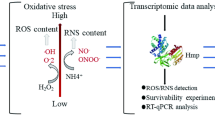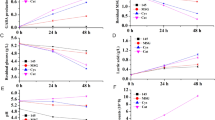Abstract
There are different studies that aim to enhance the production of nisin by Lactococcus lactis since its chemical synthesis is not possible. In this study, glutathione (GSH) and pyruvate, which are known to reduce the oxidative stress of cells, have been shown to trigger the production of nisin at both transcriptional and translational levels in L. lactis cells grown under aerobic condition. Presence of GSH and pyruvate caused more nisin yield than the heme-supplemented medium. Moreover, the expression of genes that encode stress-related enzymes were apparently upregulated in the presence of GSH and pyruvate. It can be concluded that GSH and pyruvate contribute to the defense system of L. lactis cells and so that higher biomass was obtained which in turn enhance nisin production. Antioxidant effect of GSH and pyruvate was known; however, their stimulating effect on nisin production was shown for the first time in this study.






Similar content being viewed by others
References
Punyauppa-path S, Phumkhachorn P, Rattanachaikunsopon P (2015) Nisin: production and mechanism of antimicrobial action. Int J Curr Res Rev 7(2):47
Dey BC, Rai N, Das S, Mandal S, Mandal V (2019) Partial purification, characterization and mode of action of bacteriocins produced by three strains of Pediococcus sp. J Food Sci Technol 56(5):2594–2604. https://doi.org/10.1007/s13197-019-03744-3
Hurst A (1981) Nisin. In: Advances in applied microbiology, vol 27. Elsevier, pp 85–123
Additives EPanel oF, Food NSat, Younes M, Aggett P, Aguilar F, Crebelli R, Dusemund B, Filipič M, Frutos MJ, Galtier P, Gundert-Remy U, Kuhnle GG, Lambré C, Leblanc J-C, Lillegaard IT, Moldeus P, Mortensen A, Oskarsson A, Stankovic I, Waalkens-Berendsen I, Woutersen RA, Wright M, Herman L, Tobback P, Pizzo F, Smeraldi C, Tard A, Papaioannou A, Gott D (2017) Safety of nisin (E 234) as a food additive in the light of new toxicological data and the proposed extension of use. EFSA J 15(12):e05063. https://doi.org/10.2903/j.efsa.2017.5063
Kördikanlıoğlu B, Şimşek Ö, Saris PEJ (2015) Nisin production of Lactococcus lactis N8 with hemin-stimulated cell respiration in fed-batch fermentation system. Biotechnol Prog 31(3):678–685. https://doi.org/10.1002/btpr.2075
Rochat T, Miyoshi A, Gratadoux J, Duwat P, Sourice S, Azevedo V, Langella P (2005) High-level resistance to oxidative stress in Lactococcus lactis conferred by Bacillus subtilis catalase KatE. Microbiology 151(9):3011–3018
Li Y, Hugenholtz J, Abee T, Molenaar D (2003) Glutathione protects Lactococcus lactis against oxidative stress. Appl Environ Microbiol 69(10):5739–5745
Fu R-Y, Bongers RS, Van Swam II, Chen J, Molenaar D, Kleerebezem M, Hugenholtz J, Li Y (2006) Introducing glutathione biosynthetic capability into Lactococcus lactis subsp. cremoris NZ9000 improves the oxidative-stress resistance of the host. Metab Eng 8(6):662–671
van Niel EW, Hofvendahl K, Hahn-Hägerdal B (2002) Formation and conversion of oxygen metabolites by Lactococcus lactis subsp. lactis ATCC 19435 under different growth conditions. Appl Environ Microbiol 68(9):4350–4356
Zhou FQ (2005) Pyruvate in the correction of intracellular acidosis: a metabolic basis as a novel superior buffer. Am J Nephrol 25(1):55–63
Papagianni M, Avramidis N (2012) Cloning and functional expression of the mitochondrial alternative oxidase gene (aox1) of Aspergillus niger in Lactococcus lactis and its induction by oxidizing conditions. Enzym Microb Technol 50(1):17–21
Wu H, Liu J, Miao S, Zhao Y, Zhu H, Qiao M, Saris PEJ, Qiao J (2018) Contribution of YthA, a PspC family transcriptional regulator of Lactococcus lactis F44 acid tolerance and nisin yield: a transcriptomic approach. Appl Environ Microbiol 84(6):e02483–e02417
Miao S, Wu H, Zhao Y, Caiyin Q, Li Y, Qiao J (2018) Enhancing nisin yield by engineering a small noncoding RNA anti41 and inhibiting the expression of glnR in Lactococcus lactis F44. Biotechnol Lett 40(6):941–948
Qi J, Caiyin Q, Wu H, Tian K, Wang B, Li Y, Qiao J (2017) The novel sRNA s015 improves nisin yield by increasing acid tolerance of Lactococcus lactis F44. Appl Microbiol Biotechnol 101(16):6483–6493
Zhang J, Caiyin Q, Feng W, Zhao X, Qiao B, Zhao G, Qiao J (2016) Enhance nisin yield via improving acid-tolerant capability of Lactococcus lactis F44. Sci Rep 6:27973
Tian K, Li Y, Wang B, Wu H, Caiyin Q, Zhang Z, Qiao J (2019) The genome and transcriptome of Lactococcus lactis ssp. lactis F44 and G423: insights into adaptation to the acidic environment. J Dairy Sci 102(2):1044–1058
Duwat P, Sourice S, Cesselin B, Lamberet G, Vido K, Gaudu P, Le Loir Y, Violet F, Loubière P, Gruss A (2001) Respiration capacity of the fermenting bacterium Lactococcus lactis and its positive effects on growth and survival. J Bacteriol 183(15):4509–4516
Gaudu P, Vido K, Cesselin B, Kulakauskas S, Tremblay J, Rezaïki L, Lamberet G, Sourice S, Duwat P, Gruss A (2002) Respiration capacity and consequences in Lactococcus lactis. In: Lactic Acid Bacteria: Genetics. Springer, Metabolism and Applications, pp 263–269
Rezaïki L, Cesselin B, Yamamoto Y, Vido K, Van West E, Gaudu P, Gruss A (2004) Respiration metabolism reduces oxidative and acid stress to improve long-term survival of Lactococcus lactis. Mol Microbiol 53(5):1331–1342
Pedersen MB, Garrigues C, Tuphile K, Brun C, Vido K, Bennedsen M, Møllgaard H, Gaudu P, Gruss A (2008) Impact of aeration and heme-activated respiration on Lactococcus lactis gene expression: identification of a heme-responsive operon. J Bacteriol 190(14):4903–4911
Wu Z, Xuanyuan Z, Li R, Jiang D, Li C, Xu H, Bai Y, Zhang X, Turakainen H, Saris P (2009) Mu transposition complex mutagenesis in Lactococcus lactis–identification of genes affecting nisin production. J Appl Microbiol 106(1):41–48
Cheigh C-I, Choi H-J, Park H, Kim S-B, Kook M-C, Kim T-S, Hwang J-K, Pyun Y-R (2002) Influence of growth conditions on the production of a nisin-like bacteriocin by Lactococcus lactis subsp. lactis A164 isolated from kimchi. J Biotechnol 95(3):225–235
Heath RL, Packer L (1968) Photoperoxidation in isolated chloroplasts: I. Kinetics and stoichiometry of fatty acid peroxidation. Arch Biochem Biophys 125(1):189–198
Rhee SG, Chang T-S, Jeong W, Kang D (2010) Methods for detection and measurement of hydrogen peroxide inside and outside of cells. Mol Cell 29(6):539–549
Untergasser A, Cutcutache I, Koressaar T, Ye J, Faircloth BC, Remm M, Rozen SG (2012) Primer3—new capabilities and interfaces. Nucleic Acids Res 40(15):e115–e115
Koressaar T, Remm M (2007) Enhancements and modifications of primer design program Primer3. Bioinformatics 23(10):1289–1291
Livak KJ, Schmittgen TD (2001) Analysis of relative gene expression data using real-time quantitative PCR and the 2− ΔΔCT method. Methods 25(4):402–408
Huang X, Zhang T, Goswami A, Luo F, Asefa T (2015) Glutathione-triggered release of model drug molecules from mesoporous silica nanoparticles via a non-redox process. RSC Adv 5(36):28836–28839
Grufferty RC, Condon S (1983) Effect of fermentation sugar on hydrogen peroxide accumulation by Streptococcus lactis C10. J Dairy Res 50(4):481–489
Zhang J, Fu R-Y, Hugenholtz J, Li Y, Chen J (2007) Glutathione protects Lactococcus lactis against acid stress. Appl Environ Microbiol 73(16):5268–5275
Zhang Y, Zhang Y, Zhu Y, Mao S, Li Y (2010) Proteomic analyses to reveal the protective role of glutathione in resistance of Lactococcus lactis to osmotic stress. Appl Environ Microbiol 76(10):3177–3186
Olek RA, Antosiewicz J, Popinigis J, Gabbianelli R, Fedeli D, Falcioni G (2005) Pyruvate but not lactate prevents NADH-induced myoglobin oxidation. Free Radic Biol Med 38(11):1484–1490
Vido K, Diemer H, Van Dorsselaer A, Leize E, Juillard V, Gruss A, Gaudu P (2005) Roles of thioredoxin reductase during the aerobic life of Lactococcus lactis. J Bacteriol 187(2):601–610
Jiang R, Riebel BR, Bommarius AS (2005) Comparison of alkyl hydroperoxide reductase (AhpR) and water-forming NADH oxidase from Lactococcus lactis ATCC 19435. Adv Synth Catal 347(7–8):1139–1146
Tachon S, Brandsma JB, Yvon M (2010) NoxE NADH oxidase and the electron transport chain are responsible for the ability of Lactococcus lactis to decrease the redox potential of milk. Appl Environ Microbiol 76(5):1311–1319
Duwat P, Ehrlich SD, Gruss A (1995) The recA gene of Lactococcus lactis: characterization and involvement in oxidative and thermal stress. Mol Microbiol 17(6):1121–1131
Rallu F, Gruss A, Ehrlich SD, Maguin E (2000) Acid-and multistress-resistant mutants of Lactococcus lactis: identification of intracellular stress signals. Mol Microbiol 35(3):517–528
Mulders JW, Boerrigter IJ, ROLLEMA HS, SIEZEN RJ, de VOS WM (1991) Identification and characterization of the lantibiotic nisin Z, a natural nisin variant. Eur J Biochem 201(3):581–584
Funding
This research was supported by Gebze Technical University, grant numbers 2013-A-09 and 2014-A-10.
Author information
Authors and Affiliations
Corresponding author
Ethics declarations
Conflict of interest
The authors declare that they have no conflicts of interest.
Additional information
Responsible Editor: Elaine Cristina Pereira de Martinis.
Publisher’s note
Springer Nature remains neutral with regard to jurisdictional claims in published maps and institutional affiliations.
Electronic supplementary material
ESM 1
(DOCX 18 kb)
Rights and permissions
About this article
Cite this article
Girgin Ersoy, Z., Kayıhan, C. & Tunca, S. Higher nisin yield is reached with glutathione and pyruvate compared with heme in Lactococcus lactis N8. Braz J Microbiol 51, 1247–1257 (2020). https://doi.org/10.1007/s42770-019-00216-w
Received:
Accepted:
Published:
Issue Date:
DOI: https://doi.org/10.1007/s42770-019-00216-w




